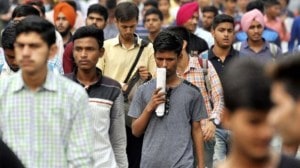RBI Governor says food inflation can’t be ignored as proposed by Economic Survey
Food inflation, with a weight of around 46 pc in the CPI basket, contributed to more than 75 pc of headline inflation in May and June
 Economic Survey, released ahead of the Budget on July 22, made a case for changing the inflation targeting framework of the central bank by excluding food inflation.
Economic Survey, released ahead of the Budget on July 22, made a case for changing the inflation targeting framework of the central bank by excluding food inflation.Differing with the views in the Economic Survey about excluding food from retail inflation, the Reserve Bank of India (RBI) on Thursday said food inflation pressures cannot be ignored with the high share of food in the consumption basket.
“First and foremost is the fact that our target is the headline inflation wherein food inflation has a weight of about 46 per cent (in consumer price index or CPI). Further, the public at large understands inflation more in terms of food inflation than the other components of headline inflation,” RBI Governor said while unveiling the monetary policy on Thursday. “Therefore, we cannot and should not become complacent merely because core inflation has fallen considerably,” he said.
Economic Survey, released ahead of the Budget on July 22, made a case for changing the inflation targeting framework of the central bank by excluding food inflation. India’s inflation targeting framework should consider targeting inflation, excluding food, as higher food prices are, more often, not demand-induced but supply-induced. Short-run monetary policy tools are meant to counteract price pressures arising out of excess aggregate demand growth, the Survey said, adding that it is “worth exploring whether India’s inflation targeting framework should target the inflation rate excluding food”.
However, Das said continuing food price shocks slowed the process of disinflation in Q1 of 2024-25. “There is also considerable divergence between headline and core inflation. This has brought to the fore the issue of how much importance should the MPC give to food inflation,” RBI Governor said.
According to Das, food inflation, with a weight of around 46 per cent in the CPI basket, contributed to more than 75 per cent of headline inflation in May and June.
“Vegetable prices increased sharply and contributed about 35 per cent to inflation in June. High inflation pressures persisted across other major food items also. On the other hand, the softening in core inflation continues to be broad-based, with core services inflation touching a new low in the current CPI series during May-June 2024.27,” Das said.
According to the Governor, equally important is the reality that high food inflation adversely affects household inflation expectations, which have a significant impact on future trajectory of inflation. Household inflation expectations, after witnessing a moderating trend between May 2022 and September 2023, have edged up on the back of high food inflation since November 2023, he said.
Das said persistently high food inflation and unanchored inflation expectations – if they materialise – could lead to spillovers to core inflation through pick-up in wages on cost-of-living considerations. “This, in turn, could be passed on by firms in the form of higher prices for services as well as goods, especially in a scenario of strong aggregate demand. Third, these behavioural changes can then result in overall inflation becoming sticky, even after food inflation recedes,” he said.
“The MPC may look through high food inflation if it is transitory; but in an environment of persisting high food inflation, as we are experiencing now, the MPC cannot afford to do so. It has to remain vigilant to prevent spillovers or second round effects from persistent food inflation and preserve the gains made so far in monetary policy credibility,” Das said.
Headline CPI inflation edged up to 5.1 per cent in June 2024 due to higher than-expected food inflation. Fuel remained in deflation for the tenth consecutive month. Core inflation moderated to a historic low in May and June.
“The high food price momentum is likely to have continued in July. Large favourable base effects may, however, push headline inflation downwards in July. The impact of the revision in milk prices and mobile tariffs needs to be watched,” he said.
A degree of relief in food inflation is expected from the pick-up in the south-west monsoon and healthy progress in sowing. Buffer stocks of cereals continue to be above the norms. Global food prices showed signs of easing in July, after registering increases since March 2024, Das said.
Assuming a normal monsoon, and taking into account the 4.9 per cent inflation print in Q1, the RBI has projected CPI inflation for 2024-25 at 4.5 per cent, with Q2 at 4.4 per cent, Q3 at 4.7 per cent, and Q4 at 4.3 per cent. CPI inflation for Q1 of 2025-26 is projected at 4.4 per cent.



- 01
- 02
- 03
- 04
- 05




























